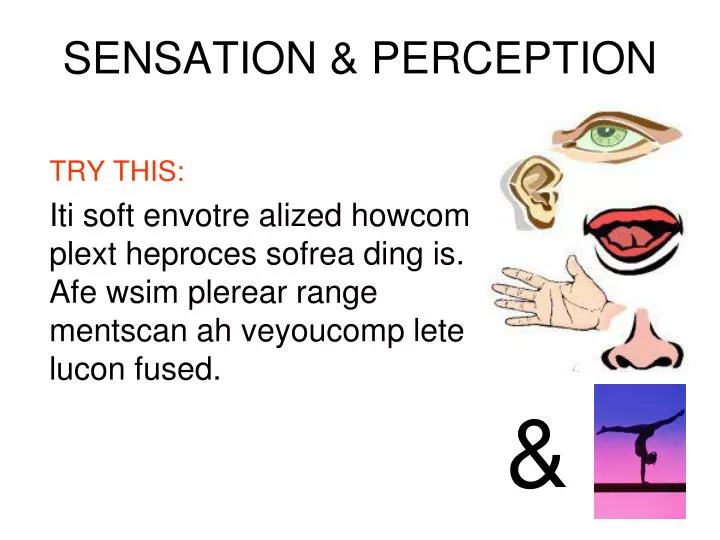

On the other hand, how we interpret those sensations is influenced by our available knowledge, our experiences, and our thoughts. Bottom-up processing refers to the fact that perceptions are built from sensory input.

Perception involves both bottom-up and top-down processing. Perception refers to the way sensory information is organized, interpreted, and consciously experienced. While our sensory receptors are constantly collecting information from the environment, it is ultimately how we interpret that information that affects how we interact with the world. Ernst Weber proposed this theory of change in difference threshold in the 1830s, and it has become known as Weber’s law: The difference threshold is a constant fraction of the original stimulus, as the example illustrates. The cell phone brightness does not change, but its ability to be detected as a change in illumination varies dramatically between the two contexts. However, if the same thing happened in a brightly lit arena during a basketball game, very few people would notice. If an audience member were to receive a text message on her cell phone which caused her screen to light up, chances are that many people would notice the change in illumination in the theater.
Sensation vs perception definition movie#
As an example, imagine yourself in a very dark movie theater. Unlike the absolute threshold, the difference threshold changes depending on the stimulus intensity. This is known as the just noticeable difference (jnd) or difference threshold. Sometimes, we are more interested in how much difference in stimuli is required to detect a difference between them. But this does not mean that we obey these messages like zombies in fact, hidden messages have little effect on behavior outside the laboratory (Kunst-Wilson & Zajonc, 1980 Rensink, 2004 Nelson, 2008 Radel, Sarrazin, Legrain, & Gobancé, 2009 Loersch, Durso, & Petty, 2013).Ībsolute thresholds are generally measured under incredibly controlled conditions in situations that are optimal for sensitivity. Research evidence shows that in laboratory settings, people can process and respond to information outside of awareness. Over the years there has been a great deal of speculation about the use of subliminal messages in advertising, rock music, and self-help audio programs. A message below that threshold is said to be subliminal: We receive it, but we are not consciously aware of it. A stimulus reaches a physiological threshold when it is strong enough to excite sensory receptors and send nerve impulses to the brain: This is an absolute threshold. It is also possible for us to get messages that are presented below the threshold for conscious awareness-these are called subliminal messages. Under quiet conditions, the hair cells (the receptor cells of the inner ear) can detect the tick of a clock 20 feet away (Galanter, 1962). It has been estimated that on a clear night, the most sensitive sensory cells in the back of the eye can detect a candle flame 30 miles away (Okawa & Sampath, 2007). The sensitivity of our sensory receptors can be quite amazing. Another way to think about this is by asking how dim can a light be or how soft can a sound be and still be detected half of the time. Absolute threshold refers to the minimum amount of stimulus energy that must be present for the stimulus to be detected 50% of the time.

The sensitivity of a given sensory system to the relevant stimuli can be expressed as an absolute threshold. We also have sensory systems that provide information about balance (the vestibular sense), body position and movement (proprioception and kinesthesia), pain (nociception), and temperature (thermoception). It turns out that this notion of five senses is oversimplified. You have probably known since elementary school that we have five senses: vision, hearing (audition), smell (olfaction), taste (gustation), and touch (somatosensation). The conversion from sensory stimulus energy to action potential is known as transduction. These cells relay messages, in the form of action potentials (as you learned when studying biopsychology), to the central nervous system. For example, light that enters the eye causes chemical changes in cells that line the back of the eye. When sensory information is detected by a sensory receptor, sensation has occurred. What does it mean to sense something? Sensory receptors are specialized neurons that respond to specific types of stimuli.


 0 kommentar(er)
0 kommentar(er)
